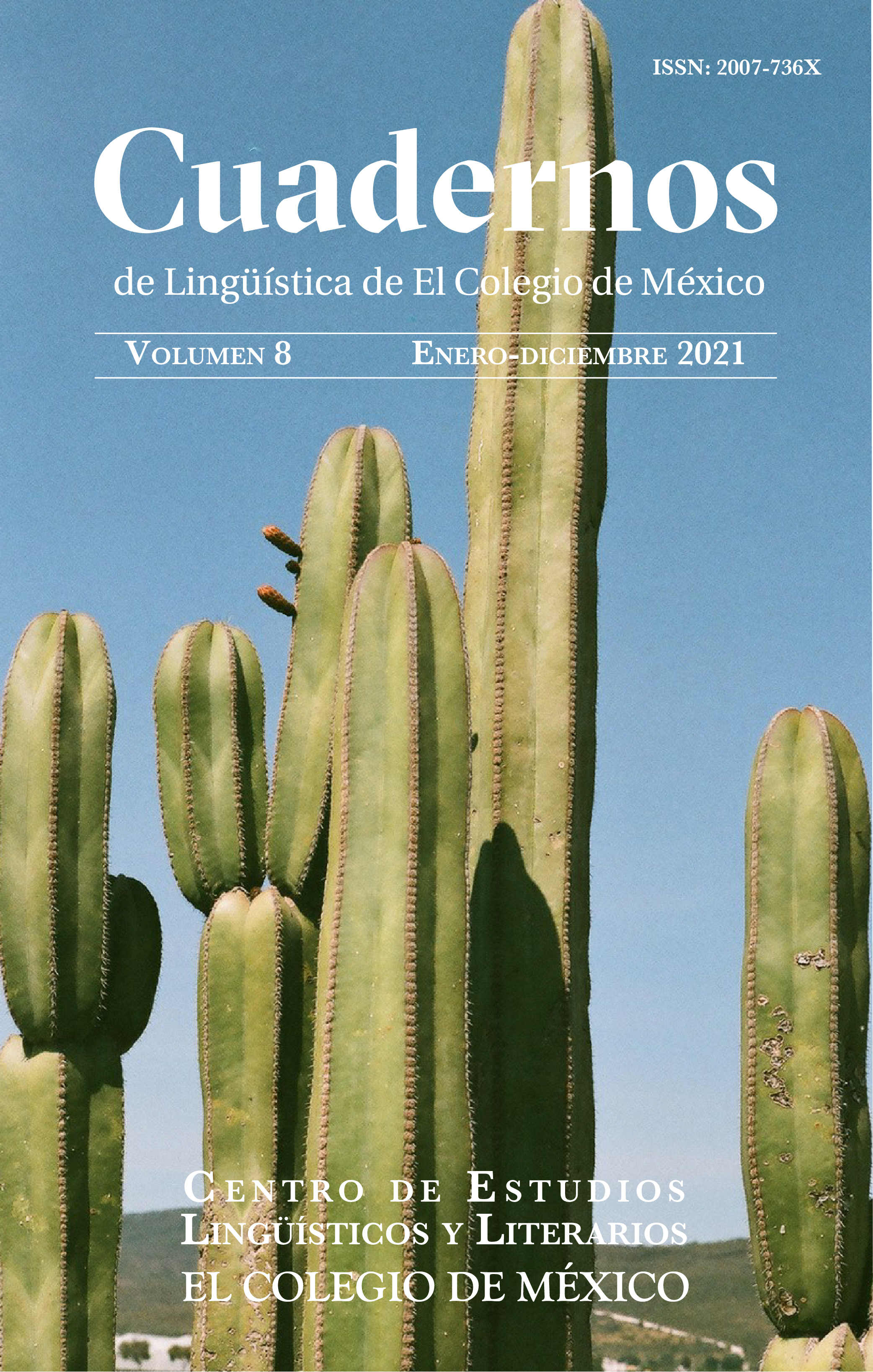Consonant Phonotactics and laryngeal features in Mazatec Languages
DOI:
https://doi.org/10.24201/clecm.v8i0.238Keywords:
mazatec, phonology, consonant clusters, laryngeal featuresAbstract
The present work describes and analyzes all the possible segmental sequences within the Mazatec languages at the level of the syllable. The basic template is CV, although in native words a complex onset of fricative and plosive is possible (consonant clusters of [+continuant][-continuant] segments). This simple syllabic structure is maintained despite a high level of laryngeal complexity, realized as secondary features. It is this analysis that determines to a large degree the possible syllabic structures of these systems. This research is based on a large corpus and linguistic documentation resulting from the Nanginá Project. We depart from the proposal that the Mazatec linguistic group consists of 10 languages, or intelligible zones, and 20 linguistic variants. This dialect proposal is illustrated with a large number of examples throughout this work, showing possible consonant clusters and examples of each zone.
Downloads
References
Agee, Daniel. 1993. Modal clitics in San Jerónimo Mazatec. SIL-México Workpapers 10. 1–28. https://mexico.sil.org/es/resources/archives/10888.
Beal, Heather D. 2011. The segments and tones of Soyaltepec Mazatec (Vol. 53). Arlington: University of Texas /SIL International.
Blankenship, Barbara. 2002. The timing of nonmodal phonation in vowels. Journal of phonetics, 30(2). 163–191. doi: 10.1006/jpho.2001.0155.
Blevins, Juliette. 1995. The syllable in phonological theory. En Goldsmith, John A. (ed.), The handbook of phonological theory, 206–44. (Blackwell Handbooks in Linguistics 1). Londres: Blackwell Publishers.
Blevins, Juliette. 2003. The independent nature of phonotactic constraints: An alternative to syllable-based approaches. En Féry, Caroline & van de Vijver, Ruben (eds.), The syllable in optimality theory, 375–403. Cambridge: Cambridge University Press.
Bull, Brian E. 1984. Aspect formation of San Jerónimo Mazatec verbs, 93–117. (Workpapers 6). México: ILV
Carlisle, Robert S. & Cutillas Espinosa, Antonio. 2015. The Production of /sC/ onsets in a markedness relationship: Investigating the ontogeny phylogeny model with longitudinal data. En Yavas, Mehemet (ed.), 183–205. Unusual productions in phonology: Universal and language. Nueva York: Psychology press.
Carrera Guerrero, Hugo. 2012. Patrones silábicos del mazateco de San Lorenzo Cuaunecuiltitla (Ponencia presentada en el Coloquio de Lingüística de la enah. Oaxaca, México).
Carrera Guerrero, Hugo. 2014. Fonología del mazateco de San Lorenzo Cuaunecuiltitla. Puebla: Benemérita Universidad Autónoma de Puebla. (Tesis de licenciatura).
Chávez Peón, Mario E. 2010. The interaction of metrical structure: tone and phonation types in Quiaviní Zapotec. Vancouver: University of British Columbia. (Tesis doctoral).
Chávez Peón, Mario E. 2018a. Proyecto Nanginá ‘nuestra tierra’. Documentación lingüística y dialectología del mazateco: metodología y resultados. En Montaño, Cynthia; Arellano, Inocencia & Sánchez, Luis Alberto (coords.), ¿Qué hacer para registrar y preservar una lengua? Aproximaciones a la documentación lingüística, 215–250. Querétaro, México: Universidad Autónoma de Querétaro.
Chávez Peón, Mario E. 2018b. Fonología de préstamos en el mazateco: adaptaciones fonotácticas. en Herrera, Esther. (ed.), Fonología segmental: procesos e interacciones, 115–147. México: El Colegio de México.
Chávez Peón, Mario E. & Hernández, Fidel. 2021. Las lenguas tonales en México. En Chávez Peón, Mario E. & de León, Lourdes (eds.), Lenguas mesoamericanas en el siglo xxi: enfoques socioculturales y tipológicos. (Colección México). México: ciesas.
Chávez Peón, Mario E.; Wagner, Carlos; Filio, Israel & García, Eloy. 2021. Las lenguas mazatecas y sus variantes. En Cardona, Pedro(ed.), Lingüística Amerindia. Querétaro: Universidad Autónoma de Querétaro.
Clements, G. Nick & Keyser, Samuel J. 1983. CV Phonology: A generative theory of the syllable (Linguistic Inquiry Monograph 9). Cambridge, MA: MIT Press.
Clements, G. N., & Hume, E. (1995). The internal organization of segments. En Goldsmith J. (ed.), Handbook of phonological theory. Cambridge, MA: Blackwell.
Clements, G. Nick. 1985. The geometry of phonological features, Phonology yearbook 2. 225–252. Cambridge: Cambridge University Press.
Clements, Nick G. 1999. Affricates as noncontoured stops. En Fujimura, Osamu; Brian, Joseph & Palek, Bohumil (eds.), Proceedings of LP ‘98: Item order in language and speech. 271-299 Praga: The Karolinum Press.
Filio García, Israel. 2011. La lengua ién Najndiaá. En Pérez López, María Soledad & Cruz García, Fanny. Las lenguas originarias de México y sus alfabetos. México: Universidad Pedagógica Nacional.
Filio García, Israel. 2014. Estructura fónica y acercamiento gramatical del Mazateco de Najndìá. México: Centro de Investigaciones y Estudios Superiores en Antropología Social. (Tesis de maestría).
García García, Eloy. 2013. Fonología segmental y sistema tonal del mazateco de Río Santiago, Huautla. México: Centro de Investigaciones y Estudios Superiores en Antropología Social. (Tesis de maestría).
García, Eloy; Chávez Peón, Mario E. & Polian, Gilles. 2012. Contrastes laríngeos en el mazateco de Río Santiago (Huautla). (Ponencia presentada en el Coloquio sobre lenguas otomangues y vecinas, Biblioteca de Investigación Juan de Córdova, 20-22 de abril de 2012, Oaxaca, México).
Goldsmith, John A. 1976. Autosegmental phonology. Cambridge: Massachusetts Institute of Technology. (Tesis doctoral).
Golston, Chris, & Kehrein, Wolfgang. 1998. Mazatec onsets and nuclei. International Journal of American Linguistics 64(4). 311–337.
González Valseca, Carlos Misael. 2021. Fonología del mazateco de Chiquihuitlán de Benito Juárez, Oaxaca. México: Escuela Nacional de Antropología e Historia. (Tesis de licenciatura).
Gregorio, Juan. 1993. Alfabeto mazateco. Oaxaca, México: Instituto Oaxaqueño de las Culturas.
Gudschinsky, Sara C. 1956. Proto-Mazatec structure. Pennsylvania: University of Pennsylvania. (Tesis de maestría).
Gudschinsky, Sara C. 1958. Mazatec dialect history: A study in miniature. Language 34(4). 469–481.
Herrera, Esther. 2003. Tono, VOT y sonoridad en el mazateco de Santa Clara, Oaxaca. En Herrera Esther. & Martín Pedro. (eds.), La tonía: dimensiones fonéticas y fonológicas. México: El Colegio de México.
Howe, Daring M. & Pulleyblank, Douglas G. 2001. Patterns and timing of glottalisation. Phonology 18(45–80).
Jamieson, Allan R. 1977. Chiquihuitlan Mazatec tone. Dallas, Texas: Summer Institute of Linguistics.
Jakobson, Roman; Fant, Gunnar & Halle, Morris. 1952. Preliminaries to speech analysis. The distinctive features and their correlates. Boston: M.I.T. Press.Kager, René. 1999. Optimality theory. Cambridge: University Press.
Kehrein, Wolfgang & Golston, Chris. 2004. A prosodic theory of laryngeal contrasts. Phonology 21(3). 325–357.
Kingston, John. 1985. The phonetics and phonology of the timing of oral and glotal events. Berkeley: Universidad de California. (Tesis doctoral).
Kirk, Paul L. 1966. Proto-Mazatec phonology. Seattle: University of Washington. (Tesis doctoral).
Kirk, Paul L. 1970. Dialect intelligibility testing: The Mazatec Study. International journal of American linguistics 36(3). 205-201.
Klint, Ryan David & Filio García, Israel. 2018. ’Ien Nájndi̠a̠, el mazateco de Mazatlán Villa de Flores. En Marlett, Stephen A. (ed.), Ilustraciones fonéticas de lenguas amerindias. Lima: SIL International y Universidad Ricardo Palma. www.lengamer.org/publicaciones/trabajos/mazateco_de_Mazatlan_afi.pdf
Ladefoged, Peter & Maddieson, Ian. 1996. The sounds of the world’s languages. Oxford, UK & Cambridge, MA: Blackwell.
Lamiman, Jon. 2013. Ixcatlan Mazatec phonology. Ms.
Léonard, Jean Léo; dell’Aquila, Vittorio & Gaillard-Corvaglia, Antonella. 2012. The almaz (Atlas Lingüístico Mazateco): From geolinguistica data procesing to typological traits. Sprachtypologie und universalienforschung 65(1). 78–94.
Léonard, Jean Léo & Fulcrand, Julien. 2016. Tonal inflection and dialectal variation in Mazatec. En Palancar, Enrique L. & Léonard, Jean Léo (eds.), Tone and inflection, 163–167. News facts and new perspectives. Berlín: Mouton de Gruyter.
Léonard, Jean Léo; Heinsalu, Els; Patriarca, Marco; Sharma, Kiran & Chakraborti, Anirban. 2017. Patterns of linguistic diffusion in space and time: The case of Mazatec. En Abergel F. et al. (eds.), Econophysics and sociophysics: Recent progress and future directions. New Economic Windows. Springer, Cham. https://doi.org/10.1007/978-3-319-477052-3_17
Ly Van Tu, Jean-Cyrille. 2015. Complexité structurale en mazatec et phonologie de laboratoire. Ms. Journée d’études du 5 mars. https://www.academia.edu/11576126/Complexit%C3%A9_structurale_en_mazatec_et_phonologie_de_laboratoire
Marlett, Stephen A. 1992. Nasalization in Mixtec languages. International journal of American linguistics 58. 425–435.
Martínez Carrera, Gloria. 2020. Ku̱i̱s’ín maxko̱a̱ ya én Ndáxa’bì k’enga sindà én, meé xá ri ’niá. Morfología verbal del mazateco de San Juan La Unión, Zoquiapam: sistema de TAM y clase flexivas. México: Centro de Investigaciones y Estudios Superiores en Antropología Social. (Tesis de maestría).
Mehmet, Yavaş. 2006. Sonority and the acquisition of #sC clusters. Journal of Multilingual Communication Disorders 4(3). 159–168.
Morelli, Frida. 1999. The phonotactics and phonology of obstruent clusters in optimality theory. Maryland: University of Maryland at College Park. (Tesis doctoral).
Nakamoto, Shun. 2020. Tonología mazateca: San Bartolomé Ayautla. México. Universidad Nacional Autónoma de México. (Tesis de maestría).
Pike, Eunice V. 1956. Tonally diferentiated allomorphs in Soyaltepec Mazatec. Chicago: The University of Chicago Press.
Pike, Kenneth L. & Pike, Eunice Victoria. 1947. Immediate constituents of Mazateco syllables. International Journal of American Linguistics 13(2). 78–91.
Prince, Alan & Smolensky, Paul. 1993. Optimality theory: Constraint interaction in generative grammar, Rutgers Technical Reports TR-2 (véase también ROA 537). [2004, Blackwell Publishers.]
Silverman, Daniel; Blankenship, Barbara; Kirk, Paul & Ladefoged, Peter. 1995. Phonetic structures in Jalapa Mazatec (Vol. Vol. 37, No. 1). Los Angeles: University of California.
Steriade, Donca. 1994. Complex onsets as single segments: The Mazateco pattern. En Cole, Jennifer & Kisseberth, Charles (eds.), Perspectives in phonology (Lecture Notes 51), 203–291. Stanford: Center for the Study of Language and Information.
Uchihara, Hiroto. 2021. Clusters vs. units in Otomanguean: the case of Tlapanec (Mè’phàà) and Zapotec (Dixsa:). Cuadernos de Lingüística de El Colegio de México 8, e224. doi: 10.24201/ clecm.v8i0.224.
Vielma Hernández, Jonathan Daniel. 2017. Panorama de los estudios lingüísticos sobre el mazateco. Cuadernos de Lingüística de El Colegio de México 4(1). 211–272.
Wagner Oviedo, Carlos de Jesús. 2017. Génesis de contrastes de estado glótico en oclusivas de las lenguas mazatecas. Manuscrito. https://www.academia.edu/35120796/G%C3%A9nesis_de_contrastes_de_estado_gl%C3%B3tico_en_oclusivas_de_las_lenguas_mazatecas.
Wagner Oviedo, Carlos de Jesús. 2018. Xi kó ts’en fañe ’én Ni̱ngo̱tsie: fonología segmental y tonal del mazateco de Ixcatlán. México: Escuela Nacional de Antropología e Historia. (Tesis de licenciatura).
Wagner Oviedo, Carlos de Jesús. 2021. Desarrollo diacrónico y distribución geográfica de las vocales en las lenguas mazatecas. Las lenguas mazatecas y sus variantes. En Cardona, Pedro (ed.), Lingüística amerindia. Querétaro: Universidad Autónoma de Querétaro.
Wagner Oviedo, Carlos de Jesús; Manzano; Miriam & Chávez Peón, Mario E. 2017. Cambio vocálico en el mazateco de Puebla y del Noroeste. (Ponencia presentada en el Congreso Internacional de Estudios sobre Lenguas Indígenas (cieli) en la Facultad de Filosofía, Universidad Autónoma de Querétaro, 15–17 noviembre.)
Xu̠ju̠n Kju̠a̠téxumare̠ Énná. Norma de escritura del mazateco. 2021. Filio García, Israel; García García, Eloy & Chávez Peón, Mario E., en colaboración con todos los participantes (eds.). México: Instituto Nacional de Lenguas Indígenas.
Zec, Draga. 2007. The syllable. En de Lacy, Paul (ed.), The Cambridge handbook of phonology. Cambridge: Cambridge University Press.
Published
How to Cite
-
Abstract1321
-
PDF (Español)410
-
XML (Español)110
-
EPUB (Español)41
-
Kindle (Español)80
-
MP3 (Español)21
Issue
Section
License
Copyright (c) 2021 Mario E. Chávez Peón, Israel Filio García

This work is licensed under a Creative Commons Attribution-NonCommercial-NoDerivatives 4.0 International License.
Authors retain copyright of their work and are free to disseminate it, make copies for any use, and/or deposit in any repository or archive of their choice, but they grant Cuadernos de Lingüística de El Colegio de México the right to publish the work for the first time. Authors agree to acknowledge Cuadernos de Lingüística de El Colegio de México as the site of original publication of their article / note / review through proper citation.
Articles appearing in Cuadernos de Lingüística de El Colegio de México are made available to readers under a Attribution-NonCommercial-NoDerivatives 4.0 International.









